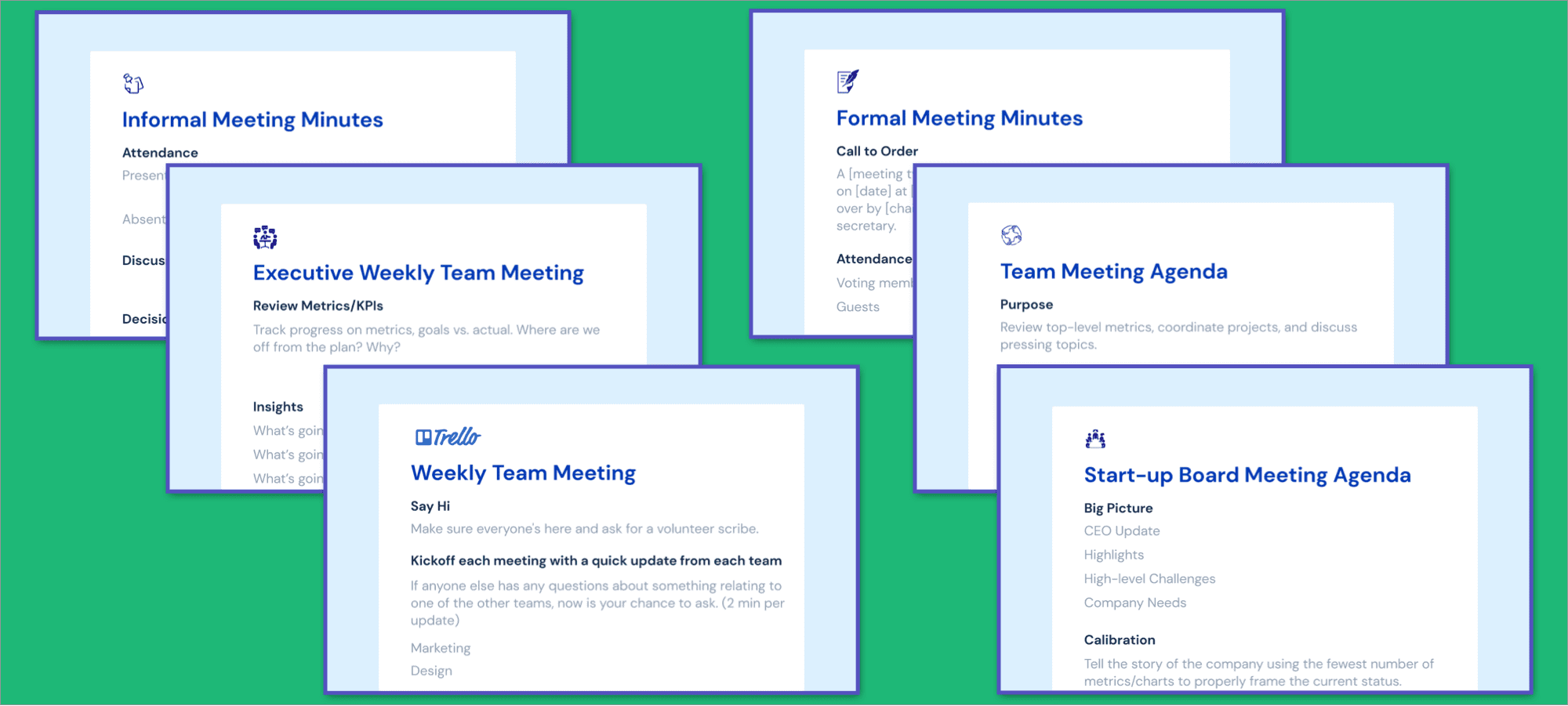Managers have it tough when it comes to meetings.
But the toughest team meeting of all might be the all-hands.
An all-hands meeting is usually the biggest, longest, least frequent, most important meeting your company has.
With so many team members attending, it costs thousands of dollars to hold. And if employees are falling asleep by the end, the waste of time, money, and resources is astronomical.
But a well-run all-hands can encourage and inspire, sharing an updated business vision with all employees, and showing them how they fit into the larger picture.
To make the most of your all-hands meeting, here are tips for running a successful one.
In this article:
- What is an all-hands meeting?
- How to plan for an all-hands meeting
- All-hands meeting agenda template
- Tips for running a successful all-hands meeting
- Benefits of holding a successful all-hands meeting
- How to follow up after an all-hands meeting
<div id="1"></div>
1. What is an all-hands meeting?
An all-hands meeting is a staff meeting where the whole department or the entire company meets at one time. It's usually scheduled for sometime during the day when most people are around. The meeting is typically long, sometimes 2 hours or more, and it happens infrequently, on a meeting cadence like once a month, quarter, or even once a year.
An all-hands meeting agenda can include updates on company news, changes that affect everyone (recent changes to benefits, new policies about current projects), or it can be structured like a training session with breakout groups.
The meeting demonstrates to employees that the company cares about them and their input, keeps them informed on what's going on in the business, and reminds everyone who is responsible for certain tasks.
<div id="2"></div>
2. How to plan for an all-hands meeting
Because of the large number of attendees at an all-hands meeting, it can be costly to hold. A few tips for planning one are:
- Have someone act as the leader or host of the meeting, because that person will be responsible for keeping it on track and relevant. If you're reading this article, this person may be you. Make sure this person has all the necessary skills to guide conversations, encourage participation, and keep distractions away.
- Schedule the meeting with enough time for everyone to get there, settle in, and be ready for it.
- To keep things moving along smoothly, share a digital copy of the agenda before the meeting starts. That way everyone is aware of what's coming up in advance and they can come prepared with any questions or comments.
- Keep the meeting time-limited to the amount you promised, or earlier. Something that has gone on too long is one of the biggest complaints about all-hands meetings - they drag on and people wonder if it's even worth it anymore.
<div id="3"></div>
3. All-hands meeting agenda template
Curious about what to cover during your all-hands? This all-hands meeting agenda template is based on some of the most successful all-hands meetings I've participated in and attended.
<div id="4"></div>
4. Tips for running a successful all-hands meeting
An all-hands meeting is an excellent tool for managers to let their employees know what's going on at the company, what the state of things are, and provide insight into any changes that are coming. This is a great time to put those amazing communication skills to use. But before you begin, here are some tips to make your all-hands meeting go more smoothly.
1) Plan ahead. Make sure you have an idea of the time commitment that you're committing to in your head when choosing when in the day to hold your meeting. You want it to be early in the morning because people will have more energy, in the afternoon when schedules are less busy, or later when there's typically less commotion.
2) Bring snacks. Even though you think everyone will be in a perfectly good mood before your meeting, they might get hangry if it runs long and they haven't had lunch yet.
3) Keep things moving at a steady pace. Some managers like to mix things up by having employees do activities during the meeting (assignments, trivia games, etc.) but make sure there's still enough talk time for everyone.
4) Involve the company. Try to encourage people to participate regardless of whether they're shy or not. Don't just focus on managers who are responsible for running the meeting, encourage general participation from everyone in the company.
5) Provide a way for people to give feedback at the end of your meeting so they can let you know if there is anything you could have done better or something they think might be helpful to keep in mind next time.
{{vital="/blog-inserts"}}
<div id="5"></div>
5. Benefits of holding a successful all-hands meeting
An all-hands meeting is a chance to get employees from different departments to understand what each other are working on and see everything in the context of the big picture.
It's also a chance to remind people what coworkers in other parts of the company do, which might not be something they think about every day. For example, sharing one or two customer stories during an all-hands meeting is a great way to help non-customer-facing roles understand the customers better.
Companies have found that holding all-hands meetings can help improve communication, morale, and growth within the business.
If you're worried about including too little information about the business in your all-hands meeting, consider scheduling a brief training session. This can be beneficial to new and old employees alike and also encourages conversations between workers who might not interact on a daily basis.
Other benefits of holding all-hands meetings are that people feel more engaged with the company and feel like they're heard. It can also help spread information on organizational changes and other relevant happenings. Employees will gain a new perspective on what other teams do.
<div id="6"></div>
6. How to follow up after an all-hands meeting
A follow-up email is a great way to ask for feedback from those who attended the all-hands meeting and let them know how much their participation and thoughts were appreciated.
You can also conduct a survey or ask people what they thought of the activities during the meeting to see what's most effective and engaging for employees.
Summary
A manager's all-hands meeting is a great way to communicate with everyone in the company regardless of what department they're in. It's also a good way to provide people with information that they might not know about each other and encourage open dialogue between workers throughout the business.
Download or copy our free all-hands meeting template and get started on preparing for your next big team meeting.
Don't let unproductive meetings slow you down
See the impact of fewer, shorter meetings, increased accountability, and enhanced productivity with Fellow.
Get started with Fellow today

.webp)


